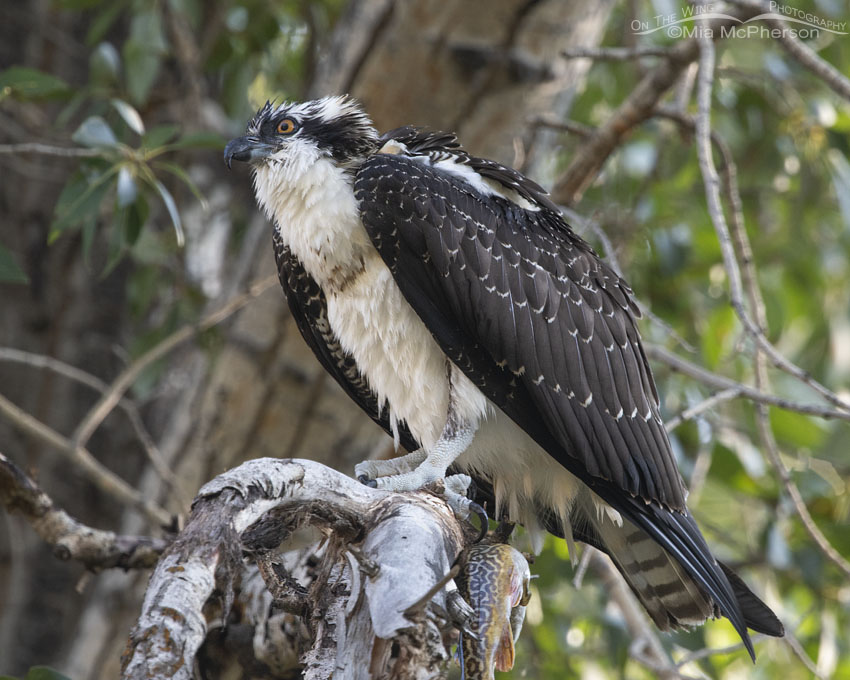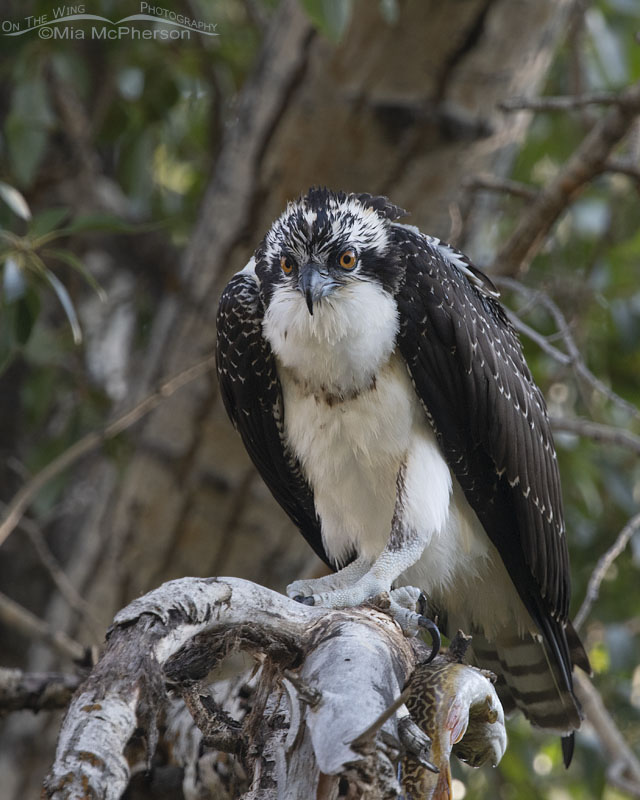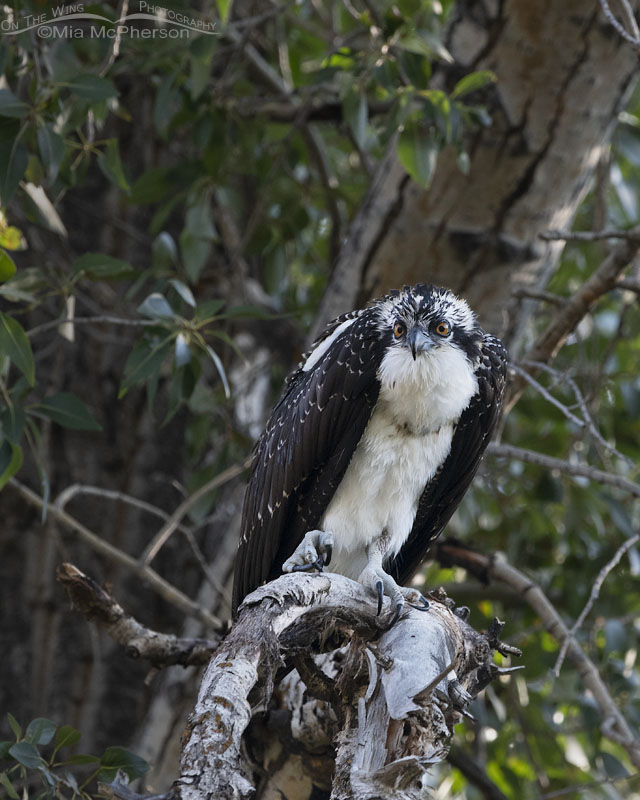One thing that I have learned over the many years that I have been photographing birds is to expect the unexpected, whether that is a rare bird, unique behavior from a subject or an unexpected opportunity with a bird. Yesterday the “unexpected” bird was a juvenile Osprey in the Wasatch Mountains. I’d say it was unexpected because I’d been photographing songbirds and wasn’t expecting to see North America’s “Fish Hawk” in the same area.
 Juvenile Osprey with a Tiger Trout – Nikon D500, f7.1, 1/160, ISO 800, -0.7 EV, Nikkor 500mm VR with 1.4x TC, natural light, not baited
Juvenile Osprey with a Tiger Trout – Nikon D500, f7.1, 1/160, ISO 800, -0.7 EV, Nikkor 500mm VR with 1.4x TC, natural light, not baited
When I first saw the Osprey it was in flight over a tree-lined road that a creek runs next to and I wasn’t even sure what the large bird was because the sunlight through the leaves of the trees made it difficult for me to see clearly. When I saw the bird again it was back lit and my brain said “heron” because that made the most sense at the time since I see herons in that same area of the creek but then my eyes and brain started working together again and I could tell that the bird was an Osprey.
Trying to take photos of the Osprey was challenging because of all the trees and having the light behind them and the bird, I adjusted my settings and hoped for the best.
As soon as I focused on the Osprey I could tell that it was a young bird that hatched this year because of the pale scaling on its wings and back plus the orange-colored eyes instead of the clear yellow eyes that adult Ospreys have. Also, because of the dark brown “necklace” below the osprey’s bulging crop I can presume that this is a young female, male Ospreys don’t usually have that “necklace”.
 Osprey juvenile with prey – Nikon D500, f7.1, 1/250, ISO 800, -1.0 EV, Nikkor 500mm VR with 1.4x TC, natural light, not baited
Osprey juvenile with prey – Nikon D500, f7.1, 1/250, ISO 800, -1.0 EV, Nikkor 500mm VR with 1.4x TC, natural light, not baited
The fish that is just below the visible talon of the juvenile Osprey is a Tiger Trout, a sterile Brook x Brown Trout (Salmo trutta × Salvelinus fontinalis) hybrid. I didn’t know that at the time, I couldn’t ID it immediately and in those moments I was more concerned about getting photos of the Osprey than I was about identifying the fish it had.
For the fish ID I am giving credit where credit is due. Brett Prettyman; a Facebook friend of mine, who is the Director of Communications at Trout Unlimited and President of the Board of Directors at Reel Recovery was able to identify my mystery fish for me as a Tiger Trout and told me that it is a fish that is commonly used by the DWR to stock ponds and there was a ranch pond nearby. Also East Canyon Reservoir was only 1.72 miles away as a crow flies.
Thanks for the ID Brett! Much appreciated, if you even need a bird ID’d you know who to reach out to.
Out West I have only fished for native trout and introduced rainbows and that was many years ago, stocking tiger trout is something that started happening after I stopped fishing.
 Juvenile Osprey flapping its wings – Nikon D500, f7.1, 1/320, ISO 800, -1.0 EV, Nikkor 500mm VR with 1.4x TC, natural light, not baited
Juvenile Osprey flapping its wings – Nikon D500, f7.1, 1/320, ISO 800, -1.0 EV, Nikkor 500mm VR with 1.4x TC, natural light, not baited
Back to the Osprey… The young Osprey seemed to struggle a little bit with its balance on the branch of the tree and started to flap its wings, I was close enough to the bird that when she flapped her wings I couldn’t fit all of her into my viewfinder. Right after this photo was taken the trout dropped from the branch and either fell unto the ground or into the creek below the osprey.
 Juvenile Osprey with a full crop – Nikon D500, f7.1, 1/250, ISO 800, -1.0 EV, Nikkor 500mm VR, natural light, not baited
Juvenile Osprey with a full crop – Nikon D500, f7.1, 1/250, ISO 800, -1.0 EV, Nikkor 500mm VR, natural light, not baited
I quickly took off my teleconverter so that I could fit the whole body of the bird into the frame in case it started to flap its wings again. I also noticed I wasn’t getting much for shutter speed but most of my images were sharp and in focus despite that.
The crop of the young osprey was already full so even though it had lost its prey I wasn’t concerned about it starving. I was a touch concerned because in almost the entire time I photographed it the osprey had its right foot and talons clenched. I don’t know why, I can’t guess why and it doesn’t do any good to wonder about it because the bird did catch the fish so it must be able to hunt despite whatever might be going on with that foot.
 Osprey juvenile regaining its balance – Nikon D500, f7.1, 1/400, ISO 1250, -0.7 EV, Nikkor 500mm VR, natural light, not baited
Osprey juvenile regaining its balance – Nikon D500, f7.1, 1/400, ISO 1250, -0.7 EV, Nikkor 500mm VR, natural light, not baited
It appeared that the Osprey looked down several times to where the trout might have landed and it lost its balance one more time before it took off and flew away. Taking my teleconverter off earlier paid off when I could fit the entire bird into the frame without clipping anything when it flapped its wings again. I missed the take off shots because of my slow shutter speed caused horrible motion blur but I was thrilled to have this juvenile Osprey in my viewfinder for as long as I did.
Life is good.
Mia
Click here to see more of my Osprey photos plus facts and information about this species.


So cool. Great pics and a fascinating narrative. Interesting observation about the osprey’s clenched foot. Hope it is not a permanent condition. Thx Mia.
I look forward to reading your blogs and seeing photographs.
Thank you for sharing.
Fascinating. You do see some amazing things.
Reading the knowledgeable commentators on Ron’s post I was reassured to learn the foot is probably ok. And that bulging crop says a great deal.
Cool story and photos.
Very nice pictures of the Osprey. I watch a couple of the nests around Missoula,Mt thru web cams. I wonder if she is from one of these nests and they are starting to fly south. I guess they go to Texas in the winter. I am not sure why but the Osprey do clutch feet when in a resting position on one foot. I believe the foot was fine. Too bad about the loss of the fish, but it is a learning experience for her so this is good if she was not hungry. Love the Osprey.
Beautiful photos and interesting/informative post as always. Thank you for sharing.
Wonderful images, MiA.
Great photos. I love ospreys. We have quite a few in the Niagara area in both Canada & USA. I was watching a nest this summer but for some reason it was abandoned towards the end of July.
A lot going in this story! Thanks for sharing the brilliant photos and the natural histories/osprey, trees, creek,fish, fish and game,angler/TU. We have a place on the Cape and over the years have seen the numbers of Osprey go from zero to at least a dozen nests in our little corner and the numbers of striped bass rebound. Quite a comeback story.
Amazing images!